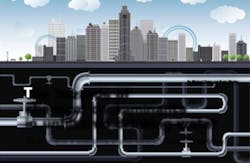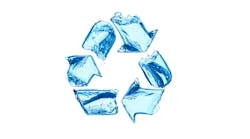The hazards of chemical contaminants in unfiltered drinking water
Physicians recommend that the average person drinks between nine and 13 cups of water a day.1 We often take for granted the fact that our drinking water is safe and clean, however, rarely pausing to think about the journey it takes from its source to our glass.
Public water systems collect both surface and groundwater and, unfortunately, neither source is isolated from contact with contaminants. Further, additional exposure to contamination can occur during drinking water treatment, or even during distribution to our homes. The wide variety of chemicals found in public water systems throughout the water treatment process, from storage to distribution, creates a continual challenge to provide an ongoing supply of safe, pure drinking water.
Failure at any stage can cause both chronic and acute health problems for anyone unlucky enough to ingest unsafe water. However, there are ways to mitigate these risks, particularly through the use of porous filtration purification. For this reason, the importance of establishing an understanding of treatment processes and maintaining diligence in water filtration solutions cannot be overstated.
How does water become contaminated?
Water is susceptible to contaminant exposure at almost every stage of its journey. During and prior to collection, surface water, or water found in rivers and lakes, is vulnerable to interaction with acid rain, stormwater runoff, pesticide runoff and industrial waste.
Groundwater, or water found in wells and other public water supplies, is susceptible to disease-producing pathogen contamination. Additionally, contact with leachate from landfills and septic systems, runoff from careless disposal of hazardous household products, leaking underground chemical storage tanks and contamination from fracking pose potential risks.
After collection, the water makes its way to a treatment plant. Although designed to clean the water and make it safe for consumption, these processing plants are not foolproof. The final stage in the treatment process, which involves disinfecting the supply with chlorine, causes concern. At this stage, the water is treated in an effort to kill any bacteria it may encounter during distribution. However, chlorine-based disinfectants may interact with naturally occurring materials in the water to create hazardous byproducts such as trihalomethanes and halogenic acetic acids (THMs and HAAs).2 In some cases, excess amounts of the disinfectant itself may be present in a drinking water supply, which can also have negative health effects.
Once treatment is complete, water is stored until it is distributed to its final destination, a process that brings its own set of potential pitfalls. Water main breaks, pressure problems, growth of microorganisms in pipes and cross contamination with sewer lines can all contribute to a hazardous travel route. Common contaminants at this stage include Giardia Lamblia and Cryptosporidium, two protozoan parasites that cause severe stomach and bowel discomfort.3
What are the potential risks?
Human contact with many of the contaminants listed above may result in any number of acute conditions including diarrhea, vomiting or irritation of the skin and eyes. More concerning are the chronic health concerns caused by neurotoxins and industrial chemicals that may be present in public water systems, which include the following:
- Perchlorate: Perchlorate is an explosive element most often used in the manufacturing of rocket and missile fuel. Poor disposal techniques and a current lack of federal regulations mean that the chemical is present in the drinking water of over 20 million Americans in at least 43 states.4 Consumption of perchlorate in drinking water has been linked to thyroid dysfunction as well as developmental health risks in infants and fetuses.5
Contaminant of the Month: Perchlorate
- THMs and HAAs: These chlorine byproducts are regulated by the EPA’s Stage 2 Disinfectants and Disinfection Byproducts Rule (DBP Rule). Under this policy, water treatment facilities are required to report byproduct levels and remain proactive towards possible future violations.6 Despite these measures, there have been several documented cases of THM and HAA contaminated water reaching the public since the rule was published.7,8 Ingestion or absorption through the skin of these contaminants can lead to cancer of the bladder, rectum, colon or breast.
- Radium: Not all neurotoxic pollution is a result of man-made processes. High levels of radium, for example, often appear in untreated groundwater. Purification techniques, such as ion exchange, have been proven to remove as much as 90 percent of the radium in a supply;9 however, long term exposure to even the smallest trace amounts can be harmful. Studies show significantly higher rates of bone, liver and breast cancer in those exposed to radium over long periods of time.
- Arsenic: Another hazardous natural element, the chemical element arsenic can appear naturally in untreated water from a variety of sources. Particularly high levels of the contaminant, on the other hand, are most likely to occur as a result of the mishandling of industrial and agricultural waste. This element often proves difficult to detect due to its lack of odor or taste. However, its harmless appearance does not indicate that it is safe to ingest and severe human exposure to arsenic has been shown to accelerate or cause the onset of Type II Diabetes, lung cancer, liver cancer and lymphatic cancer.
How can these risks be mitigated?
Whether your primary water requirements exist at the industrial or consumer levels, the best way to protect against impure and potentially harmful drinking water is to become knowledgeable about best practices in buying and utilizing filter systems and their components. The National Science Foundation and the American National Studies Institute (NSF/ANSI) have published key standards for evaluation and certification of the broad spectrum of water treatment systems. The important standards to note, as they pertain to drinking water, are as follows:
- NSF/ANSI Standard 42 – Aesthetic Effects: This standard covers point-of-use (POU) and point-of-entry (POE) systems designed to reduce specific aesthetic or non-health related contaminants, such as chlorine, taste, odor or various particulates that may be present in public or private drinking water.
- NSF/ANSI Standard 53 – Health Effects: This standard covers POU and POE systems designed to reduce specific health related contaminants, such as Cryptosporidium, Giardia, lead, volatile organic chemicals (VOCs) or MTBE (Methyl tertiary-butyl ether) that may be present in public or private drinking water.
- NSF/ANSI Standard 61 – Health Effects: This standard establishes minimum health effects requirements for materials, components, products or systems that contact drinking water, drinking water treatment chemicals or both.10
All systems, from household faucet-level units to large scale industrial water purifiers, must meet these NSF/ANSI standards. Any reputable manufacturer will prominently display NSF credentials for all filtration products (be wary of those that fail to do so). Buying and implementing the highest quality equipment is the best way to prevent chemical contamination in drinking water.
What are the other benefits of filtration?
Safe drinking water can be consistently and reliably available to you provided you have the right tools — high quality filtration components can also help reduce your costs at nearly every level of use. At the consumer level, for example, water bottle filters offer a great low-cost alternative to disposable water bottles for portable, filtered water. Brand-name bottled water often costs upwards of five cents per ounce, nearly 500 times more than most municipal water sources.11 A portable filter serves as a small upfront cost that can offset bottled water mark-ups quite quickly. End of faucet filters and under counter filters are also excellent ways to improve your water quality. Products are available in models that conform to NSF 42, and/or NSF 53 depending on your water quality needs.
Humans are not alone in our need for clean water; however, manufacturing equipment and processes can become derailed by contact with a host of contaminants. Industrial filters can be used to treat large quantities of incoming water for use, or outgoing wastewater to prevent contamination of a public water system. Optimal flow of filtered water is the key to reducing build up of grime or bacteria in industrial piping and other equipment.
If your location uses well water, other raw water sources or purification and reverse osmosis systems, consider installing plastic filter housings in order to save money over the long haul. When placed upstream of the main filter, they act as pre-filters to remove heavy sediment or other particles. Pre-filtering greatly eases over-stressing of the main filter, thereby improving its lifespan and reducing the need for maintenance.
Water filters are available to address specific contaminants that may be present in your municipal or well water. You can obtain information on the quality of your water by contacting your local water authority or visiting its website. Once you understand the contaminants that are present (or may be present) in your water, you can research filters that are designed to address those specific contaminants. Filters for contaminant removal often utilize filtration media that is specially designed to remove certain contaminants. These units utilize inner wraps and/or outer supports that are designed to contain the specific filtration media that is targeted to eliminate your specific impurities, while minimizing backflow and maintaining consistent water pressure.
Whatever your water filtering needs may be, it is imperative that you be aware of the hazards of improper filtration and sanitation. Diligent research on EPA and NSF/ANSI standards will prove invaluable in selecting quality filter components and ultimately keeping you and your equipment safe from harmful contaminants. At the consumer level, your thoroughness will help keep some extra cash in the bank and ensure a consistent supply of great-tasting water at your disposal.
References
- Mayo Clinic Staff, "Water: How Much Should You Drink Everyday?" Nutrition and Healthy Eating, 5 Aug. 2012
- "Basic Information about Disinfection Byproducts in Drinking Water: Total Trihalomethanes, Haloacetic Acids, Bromate, and Chlorite" Drinking Water Contaminants, 1 Aug. 2012
- "Drinking Water Pathogens and Their Indicators: A Reference Resource." Drinking Water Contaminants, 3 Aug. 2012
- Walker, Bill, "New data show widespread nationwide contamination." Rocket Fuel in Drinking Water, 3 Aug. 2012
- "Perchlorate." Drinking Water Contaminants, 2 Aug. 2012
- "Stage 2 Disinfectants and Disinfection Byproduct Rule (Stage 2 DBP rule)." Safe Drinking Water Act, 30 Aug. 2012
- LeBlanc, Deanna, "Monochloramine meets resistance in Rutland." WCAX.com, 17 Sep. 2012
- Brown, Stacey, "Annual Report Reveals List of Contaminants in Cumberland County Water." The Sentinel, 17 Sep. 2012
- "Radium in Drinking Water." Environmental Health Fact Sheet, 31 Aug. 2012
- "Standards." Drinking Water Treatment, 2 Aug. 2012
- Baskind, Chris, "5 Reasons Not to Drink Bottled Water." Healthy Eating, 6 Aug. 2012 http://www.mnn.com/food/healthy-eating/stories/5-reasons-not-to-drink-bottled-water
Michael J. Flater is the vice president of Global Business Development & Core Marketing for Porex Corporation. He joined Porex provider of water filtration solutions and more, in September 2007 as vice president of sales – Americas. Prior to joining Porex, he was responsible for business development and marketing for Facet Technologies, a leading supplier of medical devices to OEM customers in the diabetes marketplace.
Rusty Martin is the global director of Advanced Solutions.


